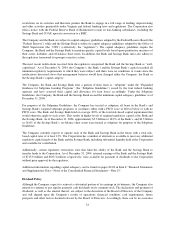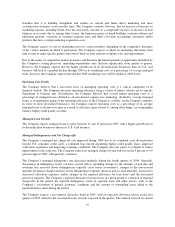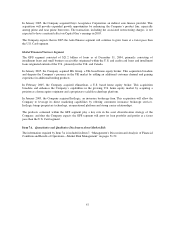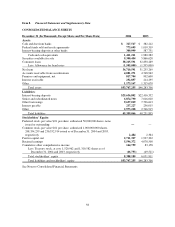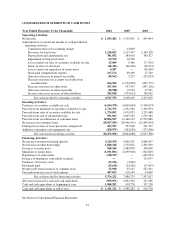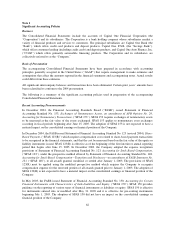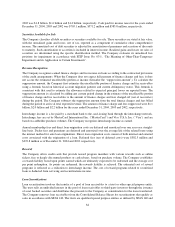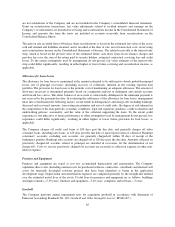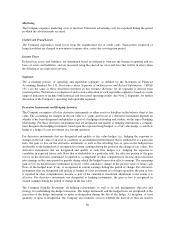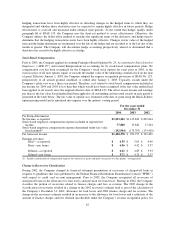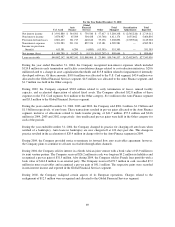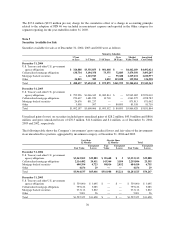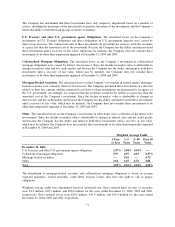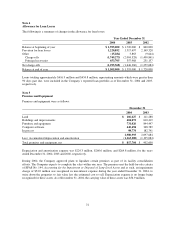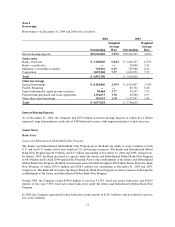Capital One 2004 Annual Report Download - page 86
Download and view the complete annual report
Please find page 86 of the 2004 Capital One annual report below. You can navigate through the pages in the report by either clicking on the pages listed below, or by using the keyword search tool below to find specific information within the annual report.In April 2003, the FASB issued Statement of Financial Accounting Standard No. 149, Amendment of Statement
133 on Derivative Instruments and Hedging Activities, (“SFAS 149”). SFAS 149 amends SFAS 133, Accounting
for Derivative Instruments and Hedging Activities, for certain decisions made by the FASB as part of the
Derivatives Implementation Group (“DIG”) process and clarifies the definition of a derivative. SFAS 149 also
contains amendments to existing accounting pronouncements to provide more consistent reporting of contracts
that are derivatives or contracts that contain embedded derivatives that require separate accounting. SFAS 149 is
generally effective for contracts entered into or modified after June 30, 2003. The adoption of SFAS 149 did not
have an impact on the consolidated earnings or financial position of the Company.
In April 2003, the FASB issued FASB Staff Position on Accounting for Accrued Interest Receivable Related to
Securitized and Sold Receivables under SFAS No. 140, (the “FSP on AIR”). The FSP on AIR adopts the
provisions of the Interagency Advisory on the Accounting Treatment of Accrued Interest Receivable Related to
Credit Card Securitizations (the “AIR Advisory”) issued jointly by the Office of the Comptroller of the Currency,
The Board of Governors of the Federal Reserve System, the Federal Deposit Insurance Corporation and the
Office of Thrift Supervision. Under the AIR Advisory and the FSP on AIR, any subordinated finance charge and
fee receivables on the investors’ interest in securitized loans should be treated as retained beneficial interests and
not reported as part of “Loans Receivable” or other terminology implying that it has not been subordinated to the
senior interests in the securitization. The FSP on AIR became effective for fiscal quarters beginning after March
31, 2003. The Company reclassified $460.6 million and $577.0 million in subordinated finance charge and fee
receivables on the investors’ interest in securitized loans for December 31, 2004 and 2003, respectively, from
“Consumer loans” to “Accounts receivable from securitizations” on the Consolidated Balance Sheets and
reclassified $69.2 million, $74.8 million, and $76.2 million for the years ended December 31, 2004, 2003, and
2002, respectively, in interest income derived from such balances from “Consumer Loan Interest Income” to
“Other Interest Income” on the Consolidated Statements of Income. Information required for the reclassification
was unavailable for periods prior to 2002.
In January 2003, the FASB issued FASB Interpretation No. 46, Consolidation of Variable Interest Entities, an
Interpretation of ARB No. 51 (“FIN 46”).In December 2003, the FASB issued FASB Interpretation 46 (Revised
December 2003), Consolidation of Variable Interest Entities, and Interpretation of ARB No. 51 (“FIN 46(R)”) to
provide clarification of certain provisions of FIN 46 as originally issued, and to defer the effective dates for
certain entities. These interpretations address consolidation of business enterprises of variable interest entities
(“VIEs”), which have certain characteristics. These characteristics include either that the equity investment at
risk is not sufficient to permit the entity to finance its activities without additional subordinated financial support
from other parties; or that the equity investors in the entity lack one or more of the essential characteristics of a
controlling financial interest. The Company elected to early adopt the provisions of FIN 46 for the interim period
ended September 30, 2003. The Company has consolidated all material VIEs for which the Company is the
primary beneficiary, as defined under FIN 46, effective July 1, 2003. The Company recorded premises and
equipment of $139.8 million, other borrowings of $178.3 million and recognized a charge of $15.0 million, net of
tax, for a cumulative effect of a change in accounting principle for the year ended December 31, 2003.
The Company has determined that it does not have any significant interest in VIEs for which it is not the primary
beneficiary. All securitization transactions that receive sale treatment under SFAS No. 140, Accounting for
Transfers and Servicing of Financial Assets and Extinguishment of Liabilities—a Replacement of SFAS No. 125
(“SFAS 140”), are accomplished through qualifying special purpose entities and such transactions are not subject
to the provisions of FIN 46(R). The Company has also evaluated the trust related to the junior subordinated
capital income securities under the provisions of FIN 46(R) and has determined that the deconsolidation of the
trust would not have a material impact on the consolidated earnings or financial position of the Company.
Cash and Cash Equivalents
Cash and cash equivalents includes cash and due from banks, federal funds sold and resale agreements and
interest-bearing deposits at other banks. Cash paid for interest for the years ended December 31, 2004, 2003 and
63


